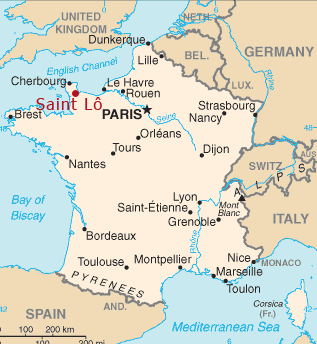St.-Lô, once a part of the grand designs of Charlemagne and Napoleon, has a powerful and direct link to 20th-century America, and especially to Western Virginia. The medieval Norman town, approximately 175 miles west of Paris, was the scene of a violent, decisive battle between American GIs and entrenched German forces shortly after the Allied landings on D-Day, June 6, 1944. The Army’s 29th Division, 116th Infantry Regiment, which was composed of many Virginians, liberated St.-Lô on July 19, 1944.
The campaign left 95 percent of the town demolished, including much of the gorgeous Gothic cathedral of Notre Dame. St.-Lô suffered more than any community in Normandy during WWII, but its people still regard America as their liberator.
Today, St.-Lô is a thriving town of 25,000 in which the past is very much present. The mainly reconstructed city lies on a rocky hill, within and around the remains of the ancient ramparts that Charlemagne began in the ninth century. There, two medieval towers provide a panoramic view of the Vire Valley and its river, which has been vital to St.-Lô’s economic history. Crossing the Vire River in downtown St.-Lô is a bridge, the Pont de Roanoke, which was dedicated in 1999. Nearby, France’s premier horse farm, Le Haras National, was established by Napoleon in 1806.
La Madeleine, a restored 13th-century chapel, houses a public exhibit about the events of 1944. The town also has a touching monument to Major Thomas Howie commander of the 3rd Battalion of the 116th Infantry Regiment. Major Howie was killed during the Allies’ final assault on the town.
Progressive St.-Lô, the administrative seat of the County of La Manche, has set its sights on becoming a university town. It supports two business colleges, the Ecole de Gestion et de Commerce and the Ecole de Ventes. Normandy’s rich soil has ensured St.-Lô’s prominence as an agricultural center as well. Dairy farms and apple orchards flourish there. The province’s creamy cheeses and fiery apple brandy, Calvados, are celebrated worldwide, and the lush, pastoral countryside attracts tourists from all corners of the globe.
Short distances from St.-Lô are several popular tourist sites, including Mont Saint Michel, Monet’s garden at Giverny and the American cemetery at Colleville-sur-Mer. The cemetery overlooks Omaha Beach, which was immortalized in Steven Spielberg’s 1998 film, “Saving Private Ryan.”

